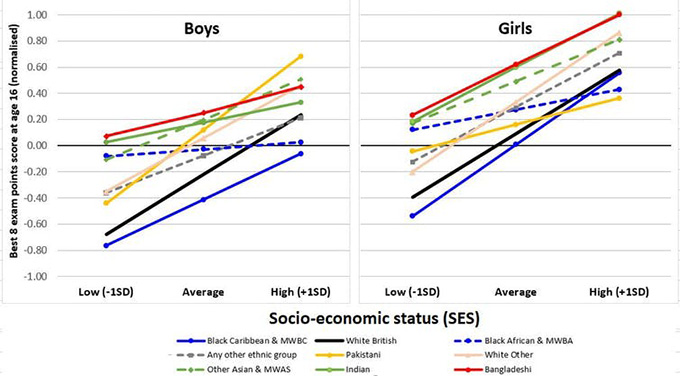
When it comes to education, we cannot think about race, sex and class in isolation. When I was commissioned by the UK government to investigate how these issues affect academic achievement, I discovered how they all matter – and in combination. I believe that an analysis that focuses on any one of these in isolation will inevitably miss important aspects of inequality.
I was tasked with analysing inequalities in educational achievement – specifically at age 16 – as part of the Commission on Race and Ethnic Disparities’ report which was published in March. The issue has been raised again recently by a report from the House of Commons education select committee that highlighted the educational outcomes of white working class children in particular.
Sixteen is when pupils sit their GCSEs and statutory full-time education in England ends. It is an important transition. The qualifications they achieve at this stage are key to their future outcomes at every level: educational, economic, health and wellbeing.
I looked at what historically have been the three central dimensions of inequality: race, sex and class (or socio-economic status). I used the Department for Education’s second longitudinal study of young people in England. This nationally representative sample of 10,000 young people sat their GCSEs in 2015/16, and is the most up-to-date and comprehensive data on race, sex, class and achievement at age 16.
The data showed that how well pupils do at GSCE level is related far more to social class – as assessed by parental occupation, education and household income – than to race or sex. For example, the achievement gap between pupils from the 20% of homes with the highest household income and the 20% of homes with the lowest household income was very large (measured at 0.91 standard deviations or SD). It was over three times larger than the small gap between boys and girls (0.29 SD), and over eight times larger than the very small gap between black and white pupils (0.11 SD). (Standard deviations are a unit of measurement used in statistics to gauge how far any given data point is from the average, or mean.)

The study calculated the achievement score of 54 unique combinations of race, sex and class. Jonathan Goldberg / Alamy Stock Photo
Comparing gaps
But it is important to look at this data in the round. Everyone has an ethnicity, sex and a class background. We don’t hold any of these characteristics in isolation.
The dataset provided a large number of categories. It included two sexes, three levels of socio-economic status (high, average and low), and nine major ethnic groups (white British, white other groups, Indian, Pakistani, Bangladeshi, other Asian, black Caribbean including mixed white and black Caribbean, black African including mixed white and black African, and any other group). With these categories, we produced 54 unique combinations of race, sex and class. We then used statistical modelling to calculate the achievement score for each of these groups. The results are shown in the graph below.

Best 8 exams point score at age 16 by race, sex and class combination.
Three of these groups performed significantly less well than white British pupils of the same sex and socio-economic status: black Caribbean and black African boys from high socio-economic status homes, and Pakistani girls from high socio-economic status homes.
Understanding these outcomes means considering them from all angles. Why is this under-achievement only noted among pupils from high status backgrounds in these ethnic groups, and why only among boys or girls respectively? My report discusses the factors which may be having an effect on these outcomes. These include how different high socio-economic status families deploy their capital, what their expectations and norms might be, what expectations the teachers in their schools might have, or cultural considerations around masculinity or identity.
But there was no ethnic under-achievement in the other 45 comparisons we made between ethnic minority and white British pupils. Indeed in two-thirds of them, the average score for pupils from ethnic minority groups was substantially higher than the mean score for white British pupils. So, where there are ethnic achievement gaps in England at age 16, they are predominantly associated with higher achievement by pupils from ethnic minority groups compared to their white British peers. This success in education has been identified before, for example in the first longitudinal study of young people in England, in 2006.
Poverty and inequality
Given the critical role of educational achievement at age 16 for life outcomes, an important question is which groups of young people are most at risk of low achievement. The data shows that young people with the lowest achievement are those from low socio-economic backgrounds. This applies particularly (though not exclusively) to white British and black Caribbean young people, and particularly to boys.
Poverty affects young people from all ethnic groups. So policies such as the pupil premium – introduced in 2011 to target funding for young people from disadvantaged backgrounds – are crucial. Such funding will also particularly support pupils from those ethnic minority groups (including Pakistani and Bangladeshi pupils) who are most likely to experience poverty.
Given the size of the class-related achievement gap, it is unclear whether the scale of the funding is sufficient. The National Audit Office concluded in 2015 that “no clear trend has been established and the gap remains wide”.
None of this denies ethnic inequalities in other educational or social outcomes, be that in entry to employment, access to high-fee universities or representation in the highest status occupations. Indeed, a key question is why high educational achievement at age 16 does not always translate into later success for young people from ethnic minorities.
If we want to help young people do better at secondary level, and improve their chances for the future, we have to think about race, sex and class in tandem. And for those students who fare the worst, great care needs to be taken to unpick at which points institutional biases might be hurting them.
Author Bio: Steve Strand is Professor of Education at the University of Oxford